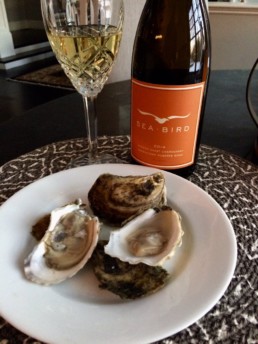Sip & Shuck Oysters | Your Guide To Oysters In September
With modern farming techniques, we are lucky to be able to enjoy oysters year around. But there’s something just a little above and beyond about enjoying food in season, and September is prime time for oysters.
If you are splurging an oyster in the US you are likely enjoying what is 95% of our farmed oyster supply. If the oysters are not farmed, they are harvested in a sustainable way so they can keep doing their essential work for our oceans. When it comes to keep our oceans thriving, oysters are the ones we can thank for maintaining the balance of their local marine ecosystem by filtering seawater through their gills, and reducing excess algae that might otherwise suffocate other marine life.
We are cracking open a bottle of crisp Chardonnay and shucking our hearts our while the last of the warm weather still makes it nice for outdoor dining while it lasts!
Why Chardonnay With Oysters?
With a crisp minerality and bright fruit notes, Chardonnay is a great pairing for oysters. You’ll want to stay clear of anything overly oaked, so a bottle of 2015 Robert’s Road Sonoma Coast Chardonnay is the perfect thing to reach for when you have a plate of bivalves to get shucking.
Best In The West Coast
Pacific oysters are small and sweet and the world's most cultivated oyster. They will tend to have a more pronounced cucumber or vegetal undertone.
Look for:
- Kumamotos - small, sweet, almost nutty oysters. They spawn later and in warmer water than other oysters, so they remain firm and sweet well into summer months. Kumamotos used to be lumped in with “Pacific oysters”, but it ends up they are their own species.
- Miyagis - these oysters tend to also have a mild nutty flavor, and are great to eat raw or even throw on the grill Rockefeller style.
- Olympias - Puget Sound and British Columbia, Olympias are sweet, coppery, and metallic. These guys are the tiniest.
Can’t Be Beat In The East
Texturally, East Coast oysters tend to be solid bites—silky to meatier, whereas West Coast will be slightly creamier, custardy.
- Bluepoints - typically harvested from the Long Island Sound, these oysters are probably the friendliest crowd-pleasers on the East Coast. They tend to have a moderate salinity, spring meat and a very light mineral finish.
- Wellfleets - plump and clean, this type of oyster is known for its good balance of creamy sweetnesss and brine thanks to the cold and relatively clean waters in the Wellfleet region.
- Malpeques - typically briner and fuller bodied than Bluepoints these meaty oysters can be found in medium tides from Malpeque Bay.
- Beausoleils- farmed in the New Brunswick region, these are about as far north as you’ll find this specimen of oyster (considered a Virginia oyster) Beausoleils are some of the most beautiful oysters thanks to their even size, and refined, light taste. These are ideal for more novice oyster eaters thanks to their light body without too much brine.
Must-have for a great oyster shucking:
Ensure your mis-en-place is ready to go with some shucking essentials. A few things you'll need to have ready:
- A glass of 2015 Sonoma Coast Chardonnay in hand, of course.
- A shucking knife
- A shucking glove (a sturdy kitchen towel will also work)
- A classic mignonette sauce
- Lemon wedges
- prepared Horseradish if you like things a tad spicy
- Cocktail sauce (use this easy DIY recipe) or pick some up at the store
Watch this video to become an expert shucker. Practice does indeed make perfect!
Much like enjoying your glass of Sea Bird Wine, eating oysters is a sensory experience! Oyster descriptors range from briny, buttery, sweet, metallic and mild. “Oyster Somms” can even pick out flavors like melon, cucumber, mushroom and more.
We love this six sense tasting guide from In A Half Shell to guide you through your shells like a pro:
My Six Steps of Pro Oyster Tasting // by In A Half Shell
- SEE: Feast with your eyes! Study the shell, shape, color.
- SMELL: It should smell sea-breezy and sweet, not fishy at all.
- SIP: Sip the oyster liquor to get a sense of the salinity.
- SLURP: Shimmy the oyster meat loose, tilt the flat edge of the shell to your lips and slurp! Don’t discard the oyster liquor (faux pas).
- SAVOR: Chew a few times to get the full body taste; notice the progression from nose (salty) to body (sweet/flavors) to finish (lingering aroma).
- SHELL: Flip the shell over and admire the collaboration between nature & farmer.
We love being able in enjoy culinary treats like oysters and wine, and it wouldn’t be possible without a healthy, thriving coastlines to allow us to grow and cultivate both of these things! While you’re shucking, we invite you to enjoy a glass of Sea Bird Wines knowing that the bottles you purchase help us donate back to marine wildlife habitat conservation efforts like the Marine Mammal Stranding Center so we can continue to preserve these amazing gifts from nature for years to come.
Shop more Sea Bird Wines here!
